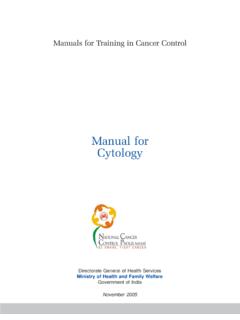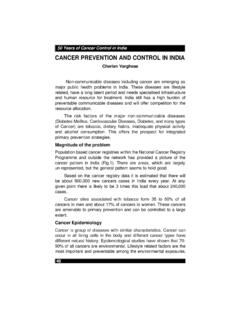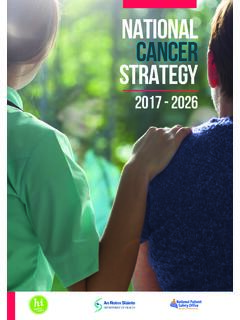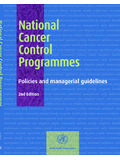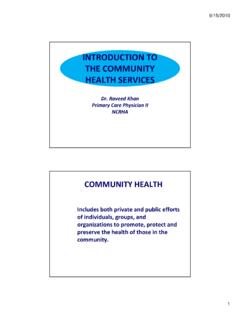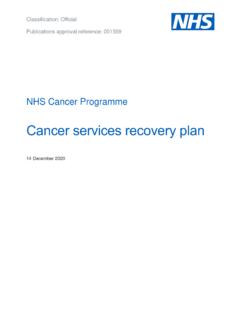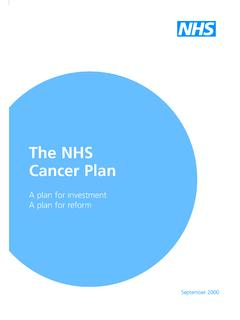Transcription of Achieving World-Class Cancer Outcomes: Taking the …
1 Achieving World-Class Cancer Outcomes: Taking the strategy forward May 2016 Introduction Radically upgrading prevention and public health Leading a national drive for earlier and faster diagnosis Putting patient experience on a par with clinical effectiveness and safety Transforming our approach to living with and beyond Cancer Investing in high-quality modern services Transforming commissioning, provision and accountability Driving investment Overseeing implementation Contents page 30 page 60 page 80 page 12 page 14 page 18 page 20 page 21 2 page 100 A Cancer diagnosis can be devastating. The first job of any strategy or plan on Cancer must be to prevent as many people from ever having to experience it in the first place. But if someone is diagnosed with Cancer , they should be able to live for as long and as well as is possible, regardless of their background or where they live.
2 They should be diagnosed early, so that the most effective treatments are available to them, and they should get the highest quality care and support from the moment Cancer is suspected. People affected by Cancer those living with it and those supporting relatives or friends with a diagnosis are the driving force for change. We know our survival rates are not good enough in this country, we know we can do more to improve patients experiences and long-term quality of life, and we know that there is unwarranted variation in outcomes between different parts of the country and for those from different backgrounds. In July, the independent Cancer Taskforce published their strategy setting out how we in England could achieve the very best Cancer outcomes by 2020. It was universally welcomed and backed by the health Arms-Length Bodies, the Government and the wider health community.
3 The strategy is comprehensive in showing how we can achieve: fewer people getting preventable cancers; more people surviving for longer after a diagnosis, with 57% of patients surviving ten years or more; more people having a positive experience of care and support; and, more people having a better long-term quality of life. We know that the aims of the strategy are ambitious and stretching. However we also know that if we do not act now to transform Cancer services, the challenges of a growing and ageing population will only become more difficult to address and we will risk not making the very necessary improvements in outcomes the strategy called for. We have committed to delivering the Taskforce s strategy by 2020. In this plan, we set out our first steps towards that, and have focussed on the major building blocks for change.
4 Over the next five years, the Taskforce s strategy will continue to stand as our guide, and implementation across the health and care system will develop to ensure that we meet all the Taskforce ambitions. Introduction 3 Introduction Prevention Early diagnosis Patient experience Living with and beyond High-quality modern services Commissioning, provision and accountability Driving investment Overseeing implementation Achieving the very best outcomes will be dependent on the effort, dedication and passion of every part of the health and care service. Clinical leaders will be front and centre of the drive for improvements in services in implementing the strategy. Working together in Cancer Alliances, clinical and other leaders from across different health and care settings in a local community will look at whole pathway data and information in the new Cancer Dashboard including survival, early diagnosis rates, treatment outcomes, patient experience and quality of life and use it to pinpoint areas for improvement locally through pathway redesign and changing clinical behaviours.
5 Cancer Alliances will be rolled out across the country from September this year. The size and shape of these Alliances are still being determined in conjunction with local teams, but will follow natural patient flows in Cancer services. They will be crucial in driving change for clinical quality and outcomes at appropriate population levels for Cancer pathways, and will be able to provide Cancer -specific leadership for the new Sustainability and Transformation Plan (STP) footprints. STPs offer an opportunity for local health communities to ensure that a focus on improving outcomes for people with Cancer is embedded firmly in the wider context of improving outcomes for a whole population. This implementation plan sets out the support that local leaders in Cancer will have from national initiatives and transformation programmes to make real the pathway improvements they determine are necessary from the data, information and experience they have in their local areas, to turn the Cancer Taskforce ambitions into reality.
6 In these straitened financial times, we must make the most of opportunities to do things more efficiently, particularly where it also benefits patients. For example, investing in online access to test results and other communications can not only improve patients experiences of care, but can also save money by removing the need for unnecessary repeat tests or appointments. As we progress with implementation of the strategy, our plans will continue to be shaped by engagement with patients, carers, families, and clinicians. Introduction 4 Introduction Prevention Early diagnosis Patient experience Living with and beyond High-quality modern services Commissioning, provision and accountability Driving investment Overseeing implementation This plan is structured according to the six strategic priorities from the Cancer Taskforce report, which have determined the six key workstreams for the implementation programme : We can achieve the very best Cancer outcomes for everyone in England, with patients and clinicians driving the transformations we need to see.
7 I look forward to working with you all to deliver this important programme to benefit all Cancer patients in England. Cally Palmer CBE national Cancer Director Introduction 5 Spearhead a radical upgrade in prevention and public health Drive a national ambition to achieve earlier diagnosis Establish patient experience on par with clinical effectiveness and safety Transform our approach to support people living with and beyond Cancer Make the necessary investments required to deliver a modern, high-quality service Ensure commissioning, provision and accountability processes are fit-for-purpose Introduction Prevention Early diagnosis Patient experience Living with and beyond High-quality modern services Commissioning, provision and accountability Driving investment Overseeing implementation Prevention 6 The first job of any strategy or plan on Cancer must be to prevent as many people from ever having to experience it in the first place.
8 With the number of Cancer diagnoses expected to reach over 300,000 a year by 2020, the Taskforce placed considerable importance on Cancer prevention activities. Our aim is to significantly reduce the 40% of cancers caused by behavioural, lifestyle and environmental factors. We will do this by engaging clinicians, commissioners and local authority providers in new initiatives to change behaviour, increasing public awareness of risk factors and health promotion, especially with vulnerable groups. We will use evidence, including NICE guidance and quality standards, to select interventions that work and develop measures and collect data to assess the effectiveness of our interventions. The work will integrate into the Public Health England (PHE) Evidence into Action strategy and the wider OneYou initiative that is already addressing the risks of tobacco, alcohol and obesity and will harness the work on chemical and environmental risks such as UV radiation.
9 For example, our whole system approach will focus efforts to identify and treat tobacco dependence, increase the number of children leaving primary school at a healthy weight and ensure that patients and the public are aware of the link between alcohol and Cancer so that individuals can understand the risks and the potential impact of the choices they make. We will also look at the initiatives for therapeutic measures to prevent cancers such as the roll-out of the HPV vaccination in cervical screening. We will work with clinical leaders through Cancer Alliances to encourage the integration of lifestyle advice and health promotion into the care and support provided to those people who are currently living with, or who are at risk of, recurrent Cancer . We recognise from previous work that success depends on many different approaches, including national campaigns, social media and the ability to translate these messages for local delivery.
10 We will therefore work with CCGs, Primary Care, Health & Wellbeing Boards, Cancer Alliances and third sector partners to embed new practices in local authorities, primary care teams and regional public health networks. Introduction Prevention Early diagnosis Patient experience Living with and beyond High-quality modern services Commissioning, provision and accountability Driving investment Overseeing implementation Prevention The Government will publish the new Tobacco control Plan by the end of 2016. Working with Public Health England and other partners, the Department of Health will publish the national childhood obesity strategy later this year. Public Health England will publish their alcohol evidence review in the autumn 2016. 7 Introduction Prevention Early diagnosis Patient experience Living with and beyond High-quality modern services Commissioning, provision and accountability Driving investment Overseeing implementation Early diagnosis Earlier diagnosis makes it more likely that patients will receive treatments which can cure Cancer .










